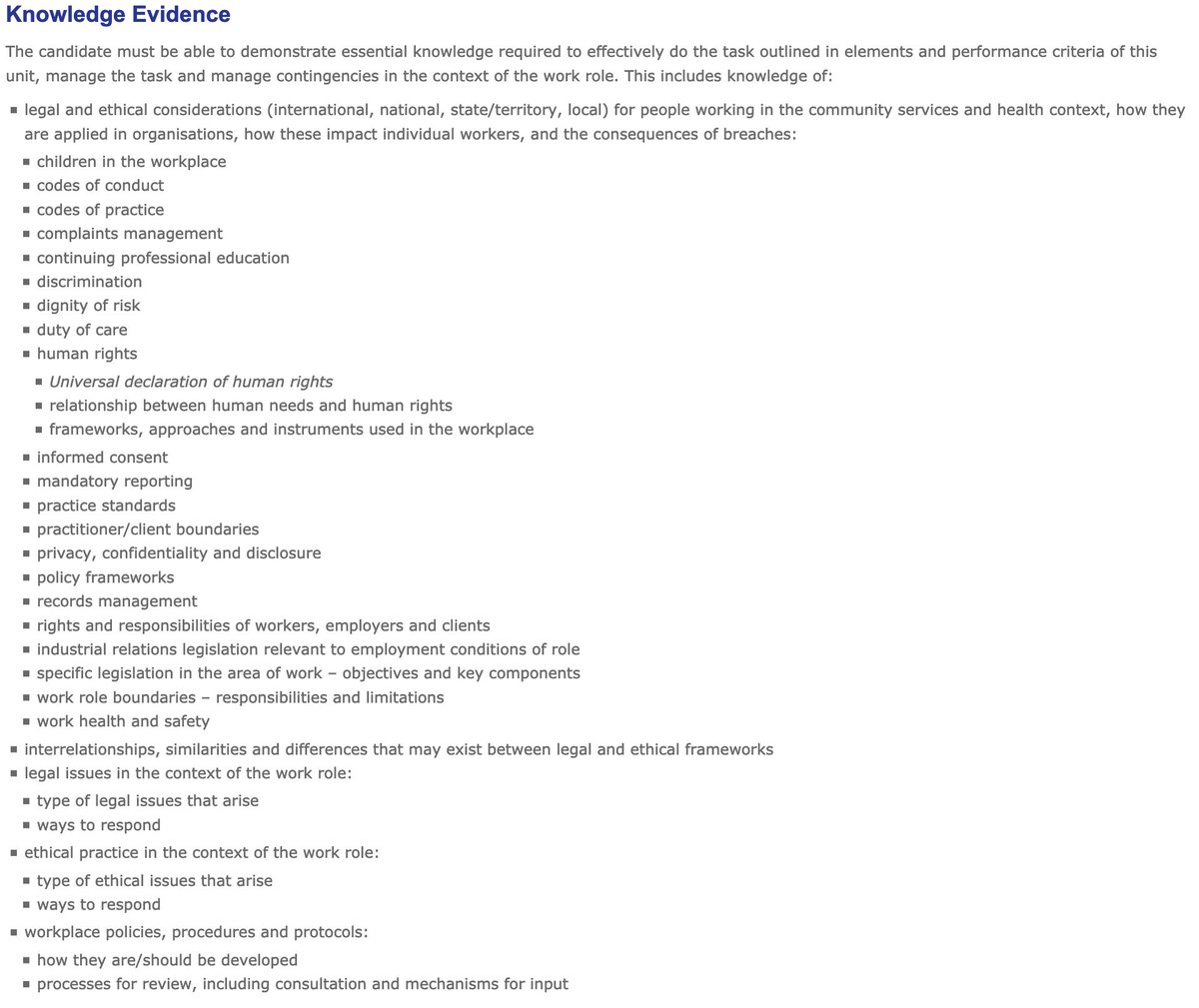In his @PressClubAust speech, Prime Minister @ScottMorrisonMP noted that one of the problems with the VET sector is the time taken to develop or upgrade training products – an average of 18months. Why is this the case? A thread.
One way to get a handle on it is to look at the core component of the VET system, the Unit of Competency (UoC). Any VET qualification is made up of a number of UoCs. They are meant to lay out what is involved in distinct areas of practical knowledge, and how they can be assessed.
Right there is the first problem: they are both a description of a skill/knowledge area AND a set of requirements for how this must be assessed. This basic complexity multiplies endlessly through the system and constantly increases what is involved in training and assessing.
Let me give you an example. Take the Unit CHCDFV001, a unit that is central to many qualifications in the Community Services area, including units at a pretty basic level (e.g. Cert III or IV).
The first part of this unit, the description of this realm of competency, contains three ‘element’ with 15 sub-elements, or ‘performance criteria’.
Many of these performance criteria are complex enough on their own. E.g. ‘1.2 Identify the scope and nature of own legal rights and responsibilities’ or ‘2.6 Use effective problem solving techniques when exposed to competing value systems’.
Imagine trying to design a set of assessment tasks that could effectively assess all 15 of these performance criteria without it ballooning into something unworkable for both learners and assessors. It’s doable, but it’s not simple at all.
But of course we haven’t got to the second part of the Unit of Competency yet: the assessment requirements. These have three components: the performance evidence, the knowledge evidence, and the assessment conditions. These mandate what needs to be shown in assessment, and how.
Now ideally, there’s a happy harmony between this performance evidence and the performance criteria. But, as you can imagine, that’s not always a simple matter at all.
Then there’s also the ‘knowledge evidence’, that is, what a learner needs to demonstrate knowledge of in order to be deemed competent. And this can really be something. Here’s the list for CHCLEG001:
Notice that some of these 35 dot points refer to areas of knowledge that are hardly basic. ‘Practitioner/client boundaries’ for example, or ‘types of ethical issues that arise’.
So now the assessment developer is trying, in addition to the task of assessing all 15 performance criteria following the guidance of the 3 performance criteria, to add assessment of 35 areas of ‘knowledge’, some of which are pretty massive.
But wait, there& #39;s more! For at the end of the unit we also find ‘Assessment conditions’, which mandate conditions in which this assessment must take place, e.g. for our unit, ‘modelling of industry operating conditions, including presence of problem solving activities’.
Considered on their own, all these elements, performance criteria, performance evidence, knowledge evidence, and assessment conditions, can make sense. That’s why we’ve ended up with them.
But of course, the whole package does not make sense at all, for what it creates is an assessment development task that is extraordinarily complex.
In my experience, the development of assessment instruments in VET is vastly more complex and time consuming than in higher education, in which I also have experience.
But you just have to do it, because in the VET system your registration is contingent upon being able to produce documented evidence of the way in which you are assessing all of this, and ASQA auditors come in regularly to check you have ticked all the boxes.
Which is why it takes 18months to change anything, because it’s a massive time and financial investment to do so, and a total headache.
What are the alternatives? I’m not sure, but I think they would emerge if we looked for them.
What are the alternatives? I’m not sure, but I think they would emerge if we looked for them.

 Read on Twitter
Read on Twitter



